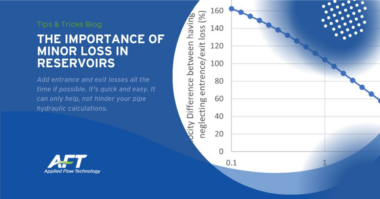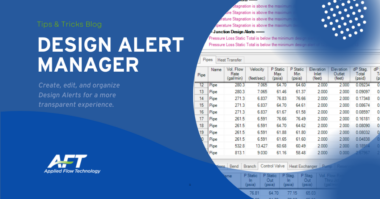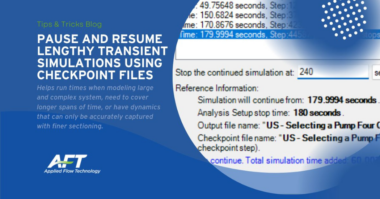Reinaldo Pinto, Applied Flow Technology’s (AFT) Technical Sales Director, has a unique perspective that many would appreciate. He works hand-in-hand with partners in over forty countries and keeps an eye on a multitude of industry sectors. On any given day you can find him educating engineers around the world to empower them to design and troubleshoot piping systems using AFT’s modeling, simulation, and analysis software.
According to Pinto, AFT’s current focus is on growth in the Middle East and India. Peru and Chile are also on their radar due to the recovery in the mining sector.
In 2022, AFT is releasing new versions for three of their main products AFT Fathom, AFT Arrow, and AFT Impulse. The advanced development of these comes shortly after they successfully released a new gas and steam transient analysis product called AFT xStream, a system optimization module called Automated Network Sizing, and the Pulsation Frequency Analysis module. It’s been a journey! Like a lot of the industry, AFT spent 2021 recovering from the COVID-19 industry shutdowns. However, like many businesses, AFT was able to adjust and pivot the obstacles. Thanks to a strong business model and leadership, they were able to retain all employees (even hire more!), development is stronger than ever and more engineers around the world took time to preform quality hydraulic analysis of their systems.
2022 is looking promising, according to the April 2021 World Economic Outlook prepared by the International Monetary Fund (IMF), the global economy is projected to experience a stronger recovery in 2021 and 2022 than indicated in previous forecasts, with global growth projected to increase at a rate of 6% in 2021 and 4.4% in 2022. Mining has increased, heating and cooling districts are looking for innovation, and the energy sectors are having a good year. All these indicators fill AFT with hope of a promising future, we are still being cautious on our expenses, but taking actions as the markets in the world slowly show signs of recovery.
Can you give a description of how AFT Impulse works?
AFT Impulse is a modelling and analysis tool used to calculate pressure surge transients in liquid piping systems caused by a sudden change in the operating condition in the system, also referred to as surge or waterhammer.
AFT Impulse incorporates a steady-state solver providing seamless transfer of initial conditions to the transient analysis. Steady-state solutions are determined using a modified Newton-Raphson matrix iteration.
First it models the steady state of the system, then it allows the user to simulate one or more changes to the operating conditions such as valve closure, relieve valve opening, pump trip, etc. AFT Impulse calculates the surge pressures that result from the changed operating conditions. The transient forces that arise from these pressures can be determined and can optionally be exported to a pipe stress program. All of these calculations assist engineers in assuring compliance with B31.3 or B31.4 codes.
Ultimately this product is geared towards a niche group of engineers who deal with these issues. It’s not a catch-all tool for everyone, but for those who need it AFT Impulse could mean the difference between efficient operation or production-halting catastrophes.
What are the advantages of the product?
The main advantage of AFT Impulse is that although it is designed to model a complex phenomenon, it uses a very friendly user interface. This interface allows users to comprehensively model, detect and solve any potential problem due to a transient condition within any hydraulic network.
What are its limitations?
The limitations of AFT Impulse originate from the complex nature of the phenomenon it intends to model. Transient analysis has many unexplored areas we must navigate. We constantly investigate, research and develop new features – as well as the use of new methodologies – to address these problems, but there are always new areas to explore.
The newest product is AFT xStream. What is it used for?
Hydraulic analysis often occurs exclusively at steady-state, but transient deviations from steady-state should face similar scrutiny. Valuable transient analysis is often overlooked in the engineering design process because it has historically been difficult to perform.
Rather than perform a transient analysis, engineers historically rely on conservative (and therefore excessively expensive) design margins. Even worse, they may cross their fingers and hope these risky events never occur, and only investigate after there is a problem.
AFT xStream allows engineers to stop the guessing games and address compressible transient events using a software tool that makes transient analysis flexible, intuitive, and efficient.
What is a compressible transient?
It’s a time-dependent deviation from standard steady-state operation of a gas or steam system where compressibility effects are significant.
These events occur in:
- Blowdowns and depressurization studies
- Turbine trip and start-up events
- Emergency shutdowns
- Relief/safety valve operation
Often these compressible transient events cannot be avoided, creating costly or dangerous concerns.
AFT developed AFT xStream, so engineers can now confidently determine, analyze, and mitigate the effects of harmful transient events by seeing how their system will react, preventing problems before they happen.
What is AFT focusing on at the moment?
Primarily, AFT is focused on integration with other engineering software to address pipe stress, plant design, GIS, etc. as well as enhanced functionality. While AFT products are regarded internationally as a leader in our field, we can always improve. In 2018, AFT began interfacing with CAESAR II Neutral files and allowing imports of Piping Component Files from SmartPlant, CADWorx and AutoCAD Plant 3D, among others. Strengthening these interfaces will continue. In 2020, AFT released the Scenario Comparison feature which has proven to be highly valuable. Looking forward, AFT is looking at speed. With software product that are already high functioning, AFT wants to “tighten up the ship” (as the common saying goes) and improve the behind-the-scenes engines that run the software.
System reliability and plant safety is always a driving factor for how we design our software. We have taken our technology a step further and included codes and industry standards references in our software output. For example, API-610 – which directly addresses the problems related to pumps operating too far from the Best Efficiency Point (BEP) by establishing recommended limits – is reported by AFT Fathom. AFT Impulse and AFT xStream’s PFA output reflects standards such as the API-674 so engineers can determine if they are in compliance with pressure pulsation magnitudes.
Additionally, AFT is working hard to help engineers model and analyze various hydraulic phenomena including acoustical resonance, steam hammer and pipe network optimization.
Finally, we are focusing on students and education. It’s not something we make money on, but we feel we have an obligation to students and universities. Currently, we have given full software licenses to multiple student researchers around the world. They have worked on projects ranging from hot water pest eradicators in California, USA to the design of a pipeline from a liquified argon tank in Australia. We created a student version of AFT Fathom that developing engineers can use for homework and AFT provides teaching packages to instructors. It’s an area of our company we are extremely proud of and really enjoy seeing the results of students’ hard work and innovation.
What trends are you seeing in the industry?
Right now, there are a lot of company acquisitions taking place in our industry. Second, we see some major growth in the refinery sector. Refineries are working more efficiently and are expanding their capabilities. Third, energy efficiency has been a big topic for several years and it’s only growing. Pumps use a lot of energy and engineers are continuously working with model and simulation scenarios to decrease energy use while maintaining, and even increasing, flow through piping and ducting systems. Governments and industries alike are making energy efficiency a priority and it is extremely interesting to be able to work with these engineers who are making efficiency possible beyond their projects’ expectations.





Comments